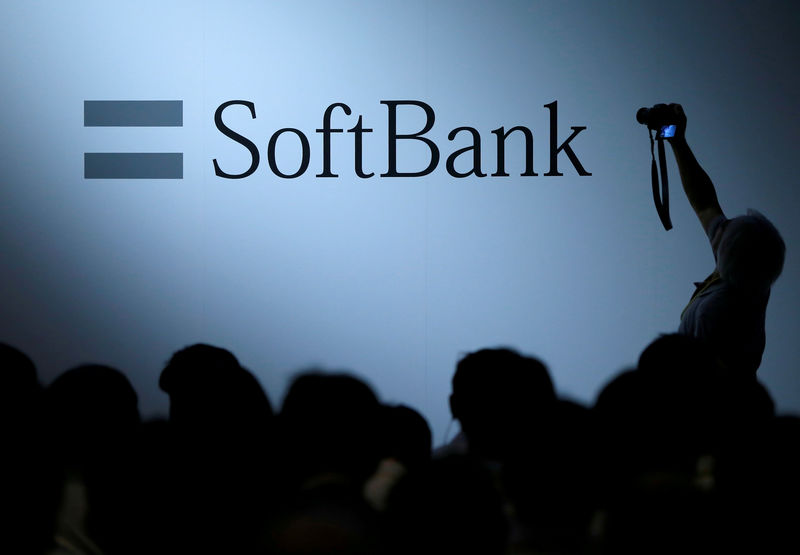By Sam Nussey
TOKYO (Reuters) - SoftBank Group Corp (T:9984) plans to use proceeds from its first Vision Fund to bankroll the $38 billion (31 billion pounds) it has committed to the second, a source said, in a show of unflinching confidence in its huge tech bets commanding sky-high valuations when sold.
The Japanese investment firm, led by artificial intelligence advocate Masayoshi Son, on Friday said it had secured pledges for a second Vision Fund totalling about $108 billion.
With over a third from SoftBank itself, however - using "distributions from Vision Fund 1 and other SoftBank assets", said the source - that headline figure depends in part on proceeds from existing Vision Fund portfolio firms listing publicly at a brisk pace in a consistently buoyant market.
SoftBank gave no breakdown for the remaining $70 billion, only saying it had signed memoranda of understanding with Microsoft Corp (O:MSFT) and Japan's three mega banks, as well as existing Vision Fund investors Apple Inc (O:AAPL) and Hon Hai Precision Industry Co Ltd (Foxconn) (TW:2317).
One newcomer is Kazakhstan's sovereign wealth fund with an investment likely under $3 billion, based on how much its government has earmarked for alternative assets.
"We are only investing a small amount, a few tens of billions of yen (few hundred million dollars), but SoftBank was insistent the amount shouldn't be disclosed," a senior executive at a Japanese financial firm said on condition of anonymity.
"Honestly speaking there's a strong sense of it being to keep up relations - you can't refuse them."
SoftBank launched its first Vision Fund two years ago. It reached a headline figure of $100 billion due primarily to the sovereign wealth funds of Saudi Arabia and Abu Dhabi - neither of which were listed on Friday as backers of the second fund.
It has already invested much of that money in disruptive start-ups in areas like financial technology, healthcare and transportation, including U.S. ride-hailing firm Uber Technologies Inc (N:UBER) and Chinese peer Didi Chuxing.
Uber is one of a number of portfolio firms to have conducted an IPO, along with messaging app maker Slack Technologies Inc (N:WORK) and blood tester Guardant Health Inc (O:GH).
"From around next year we should see IPOs of our investments nearly every month," Son told Japan's Nikkei newspaper on Saturday.
PAPER GAINS
SoftBank is an investor in the first Vision Fund but also general partner, collecting management performance fees. The two roles helped SoftBank's internal rate of return to an industry-smashing 62% just two years into the fund's 12-year lifespan.
But much of those returns are on paper - unrealised until, for the most part, shares in portfolio firms are sold following public listings. Moreover, those paper gains are at times driven upward by the internal revaluation of the portfolio companies.
SoftBank has said its valuations are often supported by co-investors or follow-on investment rounds by external parties. The two largest outside investors, Saudi Arabia and Abu Dhabi, use external valuers to double-check SoftBank's methodology.
For cash, however, SoftBank does not need to rely solely on its portfolio firms floating. The fund returned over $5 billion to investors after exiting two investments - Indian e-commerce firm Flipkart and U.S. microchip designer Nvidia Corp (O:NVDA).
The fund aims to continue returning capital during its life rather than a distributing lump sum after 12 years, said a second person with knowledge of the matter, including by employing margin loans using assets as collateral.
Such payouts would be in addition to the hefty 7% annual dividend paid to the fund's preferred shares holders regardless of performance.
Moreover, SoftBank has time to channel cash into Vision Fund 2 considering investors are likely to face capital calls only when targets have been identified, as per the first fund.
All this will reduce SoftBank's need to use debt for the second fund. Credit-rating firm Moody's Investors Service put the ratio of SoftBank's net debt compared to the value of its portfolio at 22% at the end of March. SoftBank puts the number at 16% and plans to keep it below 25%, the first person said.
PRE-VISION
Beyond the Vision Fund, other SoftBank assets include debt-laden U.S. wireless unit Sprint Corp (N:S), whose takeover by T-Mobile US Inc (O:TMUS) won antitrust approval on Friday, though the deal still faces opposition in the courts.
Its most notable asset is a stake in Chinese e-commerce giant Alibaba Group Holding Ltd (N:BABA), which is worth more than the market capitalisation of SoftBank itself. Son has held that stake since 2000 but chose to sell a small portion in 2016 ahead of the acquisition of British chip designer Arm Holdings.

SoftBank had 3.9 trillion yen ($35.91 billion) in cash and cash equivalents as at the end of March.